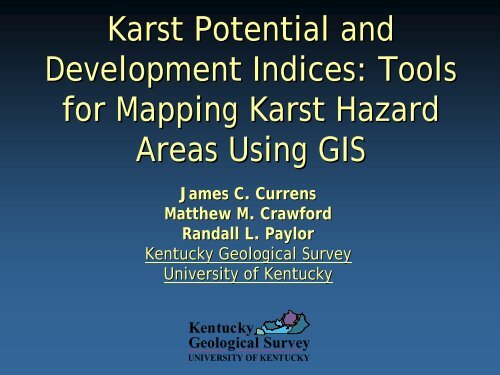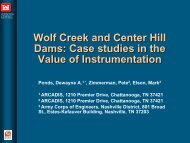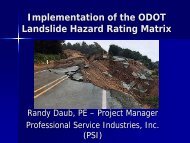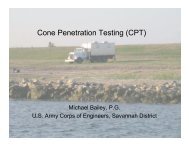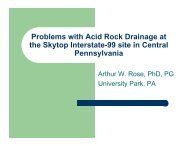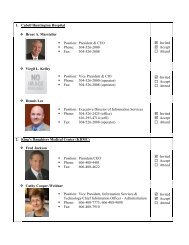Tools for mapping Karst Hazard Regions Using GIS - Marshall ...
Tools for mapping Karst Hazard Regions Using GIS - Marshall ...
Tools for mapping Karst Hazard Regions Using GIS - Marshall ...
- No tags were found...
Create successful ePaper yourself
Turn your PDF publications into a flip-book with our unique Google optimized e-Paper software.
<strong>Karst</strong> Potential andDevelopment Indices: <strong>Tools</strong><strong>for</strong> Mapping <strong>Karst</strong> <strong>Hazard</strong>Areas <strong>Using</strong> <strong>GIS</strong>James C. CurrensMatthew M. Craw<strong>for</strong>dRandall L. PaylorKentucky Geological SurveyUniversity of KentuckyKentuckyGeological SurveyUNIVERSITY OF KENTUCKY
IntroductionOver half of Kentucky has karst – primarily defined by the presence ofsoluble (calcareous) bedrock at the surface.The degree of karst development in the state is a serious planning andhazard issue that needs to be addressed on a statewide basis.Sinkhole CollapseEnvironmentalIssuesFlooding
Why a Kentucky <strong>Karst</strong> Index?• Classification schemes bring order to a collection of observations as anaid to understanding the mechanisms leading to those observations. s. Theycan be utilized as planning tools.• There have been many karst classifications proposed over the years, butmost existing classifications are subjective and non-quantitative.• Recent objective classification methodologies use labor-intensive sitespecific data <strong>for</strong> evaluation, and most of these methods do not use uthetypes of data that are available statewide in Kentucky.• The completion of the Digitally Vectorized Geologic Quadrangles <strong>for</strong>Kentucky along with new ef<strong>for</strong>ts to inventory statewide karst features nowmake it possible to evaluate the state’s karst potential and developmenton a broad scale.
Some Previous Classification Methods• DRASTIC – EPA Groundwater Sensitivity.Hydrogeologic settings <strong>for</strong>m the system and incorporate majorhydrogeologic factors that control ground-water movement: depth towater, net recharge, aquifer media, soil media, topography, impact ofthe Vadose zone media and hydraulic conductivity of the aquifer.Hydrogeologic settings are combined with these factors to create units torank pollution potential.Does not address karst issues effectively.• KARSTIC – Adaptation of EPA methods to include karstgroundwater flow.Uses data not readily available in Kentucky.
Some Previous Classification Methods• EPIK – European method.Uses four attributes: epikarst, protective cover, infiltration conditionsand karst network development, , rating and weighting them. Vulnerabilitydepends on residence time of the water in very thick soil and sedimentcover typical of alpine karst. Also takes infiltration through ponors intoaccount.Not effective <strong>for</strong> flat-lying lying Interior Plateaus province.• KISBC – Canadian method developed in British Columbia.The process considers three major criteria: 1) epikarst sensitivity; ; 2)surface karst sensitivity; ; and 3) subsurface karst potential. . Theprocedure also allows <strong>for</strong> the integration of three modifying factors: 1)fine-textured,erodible soils; 2) karst roughness; and 3) unique or unusualflora/fauna and/or habitats.Extremely field intensive and site-specific.specific.
Defining <strong>Karst</strong> Potential and <strong>Karst</strong> Development<strong>Karst</strong> Potential: A rank, based onstratigraphic and lithologic data, of areasthat are subject to the development ofcaves, sinkholes, and springs.<strong>Karst</strong> Development: A measure of “realworld” karst based on the actualpresence of caves, sinkholes, springs andsimilar features.
Dual system approachAlthough they are typically readily available,lithologic and stratigraphic data have not beenwidely used by themselves to indicate karstdevelopment.This fact suggests that <strong>GIS</strong> stratigraphy layersmust be calibrated with karst feature data be<strong>for</strong>eusing the files to make karst maps.We propose that such a dual potentialdevelopmentapproach can overcome pitfalls witheither method alone, and produce a more accuratefinal product.
COMPILING THE KARSTDEVELOPMENT INDEXCriteria and Methods
Mapped SinkholesSoil Thickness<strong>Karst</strong> Development IndexSite-specific DataCave and SpringLocationsMapped Cavesand Dye TraceRoutes
List of criteria considered <strong>for</strong> the <strong>Karst</strong> Development Index<strong>Karst</strong> DevelopmentIndex CriteriaEpikarstDevelopmentDescriptive Rangeof ValuesRange of thickness in thepolygonMedian depth to bedrockin the polygonHydrogeologicRelevance of CriteriaRelates to capacity to filterrecharge and cover-collapsecollapsesizeData Source or<strong>GIS</strong> CoverageSSURGO or measurementsin the fieldGroundwater DataRepository-Water wellsdrilled since 1984AnalogousDRASTIC FactorImpact of Vadose ZoneSinkhole DensityPercentage of polygonwithin highest mappedclosed contourRelates to capacity to filterrecharge and epikarstdevelopmentDEM, SSURGO &KGS/KSS SinkholecoverageNet RechargeIntercepted VoidsUnknown: PotentiallyZero to 50% of holedepthDirectly measures the karstporosityVoids not recorded digitally<strong>for</strong> core or other drillingrecordsHydraulic Conductivity/Missing bedrockHydrographCoefficients <strong>for</strong>Study Area SpringsCave Entrances inStudy AreaSprings within theStudy AreaDischarge or Stage0.1 to 1,000 liters/secondCount ofentrances per unit areaCount of Springs per unitareaIndirectly measures theepikarst and baselevelporosityEstimator of conduitpermeability and integrationof flowEstimator of conduitpermeability and integrationNo <strong>GIS</strong> data. Basin specificdata <strong>for</strong> a small number ofsprings availableKSS cave location database 1KGS Springs databaseHydraulic ConductivityBasin Integration: The twodata sets are of similarmode, <strong>for</strong>mat andin<strong>for</strong>mational value.Combined to provide alarger data set.Presence of InferredGroundwater routeConduit Density:Cave MapsLength of groundwaterdye-trace vectors;Percent: (cave planlength)/ (area of polygon)Integration of Flow (Ray andO’Dell, 1993)Estimator of gross porosityKGS <strong>Karst</strong> GroundwaterBasin MapsMAY NOT BEAVAILABLEHydraulic ConductivityThe two data sets arecombined to provide <strong>for</strong> alarger data set.
Criteria utilized <strong>for</strong> the KDI<strong>Karst</strong> DevelopmentIndex CriteriaEpikarstDevelopmentDescriptive Rangeof ValuesRange of thickness in thepolygonMedian depth to bedrockin the polygonHydrogeologicRelevance of CriteriaRelates to capacity to filterrecharge and cover-collapsecollapsesizeData Source or<strong>GIS</strong> CoverageSSURGO or measurementsin the fieldGroundwater DataRepository-Water wellsdrilled since 1984AnalogousDRASTIC FactorImpact of Vadose ZoneSinkhole DensityPercentage of polygonwithin highest mappedclosed contourRelates to capacity to filterrecharge and epikarstdevelopmentDEM, SSURGO &KGS/KSS SinkholecoverageNet RechargeIntercepted VoidsUnknown: PotentiallyZero to 50% of holedepthDirectly measures the karstporosityVoids not recorded digitally<strong>for</strong> core or other drillingrecordsHydraulic Conductivity/Missing bedrockHydrographCoefficients <strong>for</strong>Study Area SpringsCave Entrances inStudy AreaSprings within theStudy AreaDischarge or Stage0.1 to 1,000 liters/secondCount ofentrances per unit areaCount of Springs per unitareaIndirectly measures theepikarst and baselevelporosityEstimator of conduitpermeability and integrationof flowEstimator of conduitpermeability and integrationNo <strong>GIS</strong> data. Basin specificdata <strong>for</strong> a small number ofsprings availableKSS cave location databaseKGS Springs databaseHydraulic ConductivityBasin Integration: The twodata sets are of similarmode, <strong>for</strong>mat andin<strong>for</strong>mational value.Combined to provide alarger data set.Presence of InferredGroundwater routeConduit Density:Cave MapsLength of groundwaterdye-trace vectors;Percent: (cave planlength)/ (area of polygon)Integration of Flow (Ray andO’Dell, 1993)Estimator of gross porosityKGS <strong>Karst</strong> GroundwaterBasin MapsKSS cave map archiveHydraulic ConductivityThe two data sets arecombined to provide <strong>for</strong> alarger data set.
DVGQ of the Tell City quadrangle
Digitized 7.5-minute topographic sinkholes
<strong>Karst</strong> conduit trace vectors
Cave and Spring Locations
Depth to bedrock measurements
Final KDI polygon cut
Scoring matrix <strong>for</strong> evaluating the <strong>Karst</strong> Development IndexSinkhole Area RatioPercent Coverage (R C)W = 4 ⇒> 75%th Quartileover 7.114 th4350% to 75%3 rd Quartile2.06 to 7.11226% to 50%2 nd Quartile2.06 to 0.3910% to 25%1 st Quartilelest than 0.39Depth to Bedrock(Surrogate <strong>for</strong>Epikarst Development)W= 1 ⇓4Conduit Density:4 th Quartile> 0.39 km/km 2HighlyDeveloped<strong>Karst</strong>Depth< 2.5m (7.5ft)43ConduitDensity:3 rd Quartile0.24 to 0.39 km/km 2WellDeveloped<strong>Karst</strong>Depth3.3 m to 5m(8 to 32 ft.)32Conduit Density:2 nd Quartile0.09 to 0.24 km/km 2ModeratelyDeveloped<strong>Karst</strong>Depth 3.3 mto 15 m(13 to 15 ft.)21Conduit Density: 1 stQuartile< 0.09 km/km 2PoorlyDeveloped<strong>Karst</strong>Depth> 4.65 m(> 15 ft.)1⇑Length of SurveyedCave or InferredGroundwater FlowRoute per unit areaW = 2Caveand Spring Density4 thQuartileGreater than 0.52per km 24Caveand Spring Density3 rd QuartileFrom 0.26 to 0.52per km 23Caveand Spring Density2 nd QuartileFrom 0.15 to 0.26per km 22Caveand Spring Density1 st QuartileLess than 0.15per km 21⇐ Number of CaveEntrances and Springsper unit area ofPolygon W = 3
COMPILING THE KARSTPOTENTIAL INDEXCriteria and Methods
StratigraphyLithology<strong>Karst</strong> Potential% insolubles===50%highmoderatelow
Kentucky <strong>Karst</strong> Potential Map based on 500,000-scale geology
List of criteria considered <strong>for</strong> the <strong>Karst</strong> Potential Index<strong>Karst</strong> PotentialIndex CriteriaDescriptive Rangeof ValuesHydrogeologicRelevance of CriteriaData Source or<strong>GIS</strong> CoverageEquivalentDRASTIC FactorMineralogy of thecarbonate rockLess than 10% to100%Solubility of thecarbonate unitLithologic or mineralogicdescriptions in geologicreports and on mapsNoneBedding ThicknessLess than 10 cm to100cmInitial flow pathavailability andmechanical strength <strong>for</strong>conduit developmentLithologic descriptions instratigraphic and othergeologic reports and mapsNoneGrain SizeRange in diameters:equivalent clay grainsize to pebble sizeSolubilityLithologic descriptions instratigraphic and othergeologic reports and mapsNonePercentage ofStratigraphic Unitthat is InsolubleLess than 5% to 100%Directly measures theepikarst and base levelporosityLithologic descriptions instratigraphic and othergeologic reports and mapNoneJoint Spacing5 cm to100's of cmInfluences DirectRecharge and AdditionalIndicator of EpikarstDevelopmentNo <strong>GIS</strong> data. Basinspecific data <strong>for</strong> a smallnumber of springsavailableHydraulic ConductivityClimate0 to many meters ofprecipitationDirectly measuresrechargeNational and StateClimate Center DatabasesRecharge
Criteria utilized <strong>for</strong> the <strong>Karst</strong> Potential Index<strong>Karst</strong> PotentialIndex CriteriaDescriptive Rangeof ValuesHydrogeologicRelevance of CriteriaData Source or<strong>GIS</strong> CoverageEquivalentDRASTIC FactorMineralogy of thecarbonate rockLess than 10% to100%Solubility of thecarbonate unitLithologic or mineralogicdescriptions in geologicreports and on mapsNoneBedding ThicknessLess than 10 cm to100cmInitial flow pathavailability andmechanical strength <strong>for</strong>conduit developmentLithologic descriptions instratigraphic and othergeologic reports and mapsNoneGrain SizeRange in diameters:equivalent clay grainsize to pebble sizeSolubilityLithologic descriptions instratigraphic and othergeologic reports and mapsNonePercentage ofStratigraphic Unitthat is InsolubleLess than 5% to 100%Directly measures theepikarst and base levelporosityLithologic descriptions instratigraphic and othergeologic reports and mapNoneJoint Spacing5 cm to100's of cmInfluences DirectRecharge and AdditionalIndicator of EpikarstDevelopmentNo <strong>GIS</strong> data. Basinspecific data <strong>for</strong> a smallnumber of springsavailableHydraulic ConductivityClimate0 to many meters ofprecipitationDirectly measuresrechargeNational and StateClimate Center DatabasesRecharge
Lithologic data gathering
New lithologic attribute data compiled
Scoring matrix <strong>for</strong> evaluating the <strong>Karst</strong> Potential IndexPercentage of Insoluble Rocks andMinerals in the Stratigraphic UnitW = 4 ⇒100cm4390% to 50% CalciumCarbonate (Dolomitic(Limestone)High PotentialThick30-100cm3250% to 10% CalciumCarbonate (Calcitic(Dolostone)ModeratePotentialMedium10-30cm21
<strong>Karst</strong> Index Calibration
<strong>Karst</strong> Index Calibration
<strong>Karst</strong> Index Calibration
Final <strong>Karst</strong> Index applied to DVGQs
Comparison with 500k map
Final <strong>Karst</strong> Index applied to DVGQs – Original Data
Final <strong>Karst</strong> Index applied to DVGQs
Final <strong>Karst</strong> Index applied to DVGQs
DISCUSSION• The KDI/KPI project has developed a regional karst classification n methodthat is more appropriate <strong>for</strong> Kentucky and the Interior Plateaus provincethan previously used methods.• The KDI and KPI methods correlate well, suggesting that they are goodcriteria <strong>for</strong> classifying karst in Kentucky.• The detailed karst maps produced from this study can aid in many areas,including planning, hazard evaluation and environmental investigations.• Groundwater issues are not directly addressed using the KDI/KPIclassification, but it can be used to augment karst groundwaterclassification methods. Does not currently address non-karst catchmentsdraining onto karst areas.• The classification system proposed here does not remove the necessity<strong>for</strong> field investigations when evaluating site specific karst issues.
http://www.uky.edu/KGS/gis/sinkpick.htm
Groundwater dye tracing can delineate drainagebasins and identify general conduit flow routes
http://kgsweb.uky.edu/findpubsmain.aspsearch:karst
Surveys by cavers directly reveal karst porosity andgroundwater flow routes
http://www.ksscaves.orgwww.ksscaves.org/
Further Work• The KDI as currently calculated is based on four 100K quad sheets. s. TheKDI will be evaluated <strong>for</strong> all the remaining quads and recalculated ed <strong>for</strong>more accurate results.• Investigate the use of relief (derived from DEMs) ) to further refine theKDI matrix.• Address the problem of “quad boundary faults” where necessary.• Include the final <strong>Karst</strong> Index map as a base layer on the KGS InternetMap Server.
ContactsKentucky Geological Survey228 Mining and Minerals BldgUniversity of Kentucky, Lexington, KY 40065859-257257-55005500<strong>Karst</strong> Issues:•James C. Currenscurrens@uky.edu•Randall L. Paylorrpaylor@uky.edu<strong>GIS</strong>:•Matthew M. Craw<strong>for</strong>dmcraw<strong>for</strong>d@uky.edu


